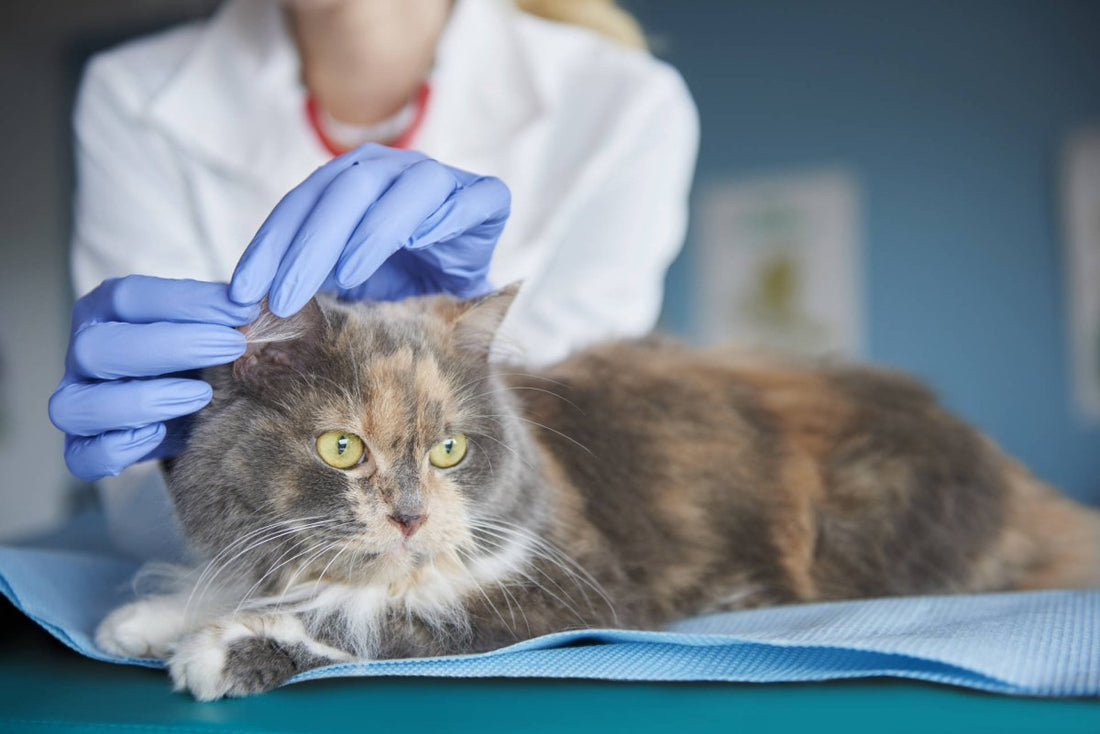Ear mites in cats: Invisible pests with a big impact
Ear mites are tiny but extremely annoying parasites that primarily infest your cat's ears. They cause itching, inflammation, and, if left untreated, can lead to serious infections. But don't worry—with the right treatment and prevention, you can help your cat quickly. In this blog, we'll show you everything you need to know about ear mites in cats, from symptoms and treatment options to practical prevention tips.
What are ear mites and how dangerous are they?
Ear mites (Otodectes cynotis) are tiny parasites that live in the ear canals of cats. They feed on skin flakes and secretions, causing severe itching and inflammation.
Important to know:
- Ear mites are highly contagious and can be transmitted from cat to cat or even from dog to cat.
- Without treatment, they can lead to serious ear infections and permanent damage.
Symptoms: How do you recognize ear mites in cats?
Ear mites are difficult to detect with the naked eye, but the symptoms are usually clear.
Typical signs of ear mites:
- Itching: Your cat constantly scratches its ears or shakes its head.
- Encrustations: Dark, crumbly earwax that resembles coffee grounds.
- Redness and inflammation: The ears are red and sensitive.
- Unpleasant odor: Infections can cause a strong odor.
- Restlessness: Your cat seems irritable and sleeps less well.
If you notice one or more of these symptoms, you should consult a veterinarian.
How are ear mites diagnosed in cats?
Diagnosing ear mites is easy and is usually done directly by the veterinarian.
Diagnostic methods:
- Ear examination: The veterinarian uses an otoscope to check for crusts and inflammation.
- Microscopic analysis: A swab from the ear is examined for mites and eggs.
- Exclusion of other causes: Infections or foreign bodies can cause similar symptoms.
Treating ear mites in cats: The best methods
Treating ear mites is straightforward but requires consistency. The mites must be completely removed to prevent re-infection.
1. Medication
- Spot-on preparations: Medications such as selamectin or moxidectin are applied to the skin and have a systemic effect against the mites.
- Ear drops: Special drops kill the mites directly in the ear.
- Antibiotics: Infections caused by scratching may require antibiotics.
2. Ear cleaning
- Before treatment, the ears should be cleaned of crusts and dirt.
- Use special ear cleaners for cats – not cotton swabs!
3. Home remedies
- Ear mite oil: A natural remedy made from olive oil or coconut oil can help suffocate mites.
- Tea tree oil: Use only in very diluted form and after consulting a veterinarian, as it can be toxic to cats.
How long does the treatment take?
Treatment typically lasts 7–14 days, depending on the severity of the infestation. A follow-up check with your veterinarian is important to ensure all mites have been eliminated.
Prevention: How to protect your cat from ear mites
Ear mites are highly contagious, so prevention is particularly important – especially if your cat is an outdoor cat or lives with other animals.
Tips for prevention:
- Regular check-ups: Check your cat's ears regularly for crusting and inflammation.
- Flea and mite prophylaxis: Spot-on preparations protect not only against fleas but also against ear mites.
- Hygiene: Clean your cat’s sleeping areas and blankets regularly.
- Quarantine: Isolate new or infected animals until they are mite-free.
Are ear mites transmissible to humans?
The good news: Ear mites usually only infest animals. Transmission to humans is extremely rare. Nevertheless, hygiene is important to prevent their spread within the home.
Frequently asked questions about ear mites in cats
“Are ear mites dangerous for cats?”
Yes, if left untreated they can lead to serious infections, hearing loss and chronic inflammation.
“Can I treat ear mites myself?”
You can treat mild cases with ear mite oil, but severe infestations require a visit to the vet.
“How do I know if the mites are gone?”
The itching and crusting should disappear completely after treatment. A follow-up examination will provide reassurance.
“How often should I clean my cat’s ears?”
Only when necessary or as directed by a veterinarian. Excessive cleaning can irritate the ears.
Conclusion: Ear mites in cats – small but mighty
Ear mites may be tiny, but they can cause significant damage if left untreated. With proper treatment and hygiene, you can help your cat quickly. The most important points at a glance:
- Recognize symptoms: Itching, crusting, and inflammation are typical signs.
- Treat: Medications such as spot-on preparations and ear cleaners are effective.
- Prevention: Regular check-ups and hygiene protect against re-infection.
With a little attention and care, ear mites will quickly become history – and your cat can purr through life in peace again!



